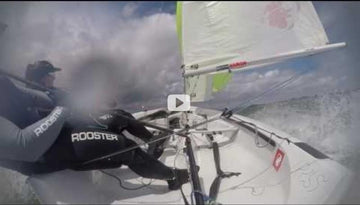Winter is the time for fixing and upgrading your boat. It’s not always the most fun thing to do but definitely worth it when the season comes. We have recently been sorting our new RS200 for the year ahead and here are our key hints and tips for rigging a brand new RS200!

Setting up the rig
Deflection:
The deflection of the spreaders is the key driver for setting the initial bend in the mast and is measured with no rig tension on the mast. The spreaders keep the mast in column with your desired set up by using the force through the shrouds to push on the mast. The deflection helps to induce bend into the mast to help mould the main into the correct shape and there are two ways of adjusting this; change the length of the spreaders or sweep them backwards by adjusting the inboard end.
The length of the spreaders will also dictate the side to side stiffness of the mast, the longer they are the less bend to windward will be allowed, in theory allowing the rig to depower less through the “slot” between main and jib. The “sweep” will induce fore and aft bend, with more bend flattening the main sail and therefore depowering the sail.
Measuring the length is simple, measure from the inboard end to where the shroud attaches to the spreader. Measuring the sweep is a bit more difficult. You measure the deflection at the midpoint of the straight line between where the two shrouds attached. The easiest way to do this is to tie a piece of twine between the two attachment points and then measure from the back of the mast track to the twine.
The settings that we aim for is: Length: 385mm Deflection: 135mmA tweak that you can make is to have twist adjusting spreaders. These will allow easy adjustment and in some classes where you change all settings between gears you can adjust them on the water without having the issues of dropping pins.
The mast rake is how upright the mast is. This is measured by taking a tape measure from the top of the mast to the stern of the boat, in terms of a 200 to the highest point on the rear hatch housing. This must be done with the rig tension on. In order to ensure that the measurement that you take is replicated each time you need to make sure you measure the distance from the top of the mast to the black/white band by the gooseneck and make sure this is the same each time.
For us the measurements are as follows (apologies for the change in units): To gooseneck band – 540cm Mast rake to top of back tank – 21' 9" Rig tension – 29 (loos gauge)We only sail with one setting and control the rest of the rig with the kicker as we are a slightly heavier team. Lighter teams tend to rake back when going through the wind range to as far as 21’6”.
When the tension is applied you should find that the mast is slightly inverted before the mainsail is hoisted.
Tweaks and tips Gybe Strop
The gybe strop hangs down from the inboard mainsheet block on the boom. It allows the helm to pull the boom over more effectively through the gybe by allowing them a 1-1 purchase. This is especially useful in breezy conditions where the boom needs an extra flick to bring it across. The gybe strop should be about 40cm long.
It is worth noting that the gybe strop cannot be used to pump the boom and this is stated in the class rules.
Mainsheet boom cover
This allows the mainsheet to run freely outside the boom, but it stops the mainsheet from hanging down at neck height through a gybe or tack when it goes slack. Obviously, this is a useful safety mechanism, but also a decapitated helm tends to lead to a capsize which is not fast.
Continuous control lines
On any boat you have sailed you are likely to have to go to a windward or leeward mark, needing to adjust the control lines, only to find that there is no slack left to allow you to adjust the controls. By making the lines continuous you will not have this problem. All you need to do is to run the lines thorough the whole system as per usual with enough extra line that you could sit on the opposite side holding it. Then you need to splice the two ends of the lines together. Rooster does a product called EasiSplice Continuous Control Line and they show you how to splice the ends in an easy to follow video here.

I would recommend using the Rooster Easysplice, but if you have had the continuous lines completed by RS PLEASE CHECK!!! In my experience RS have tied the 2 ends together with twine and this will not hold when under pressure.
Mainsheet bridle
My preference on the 200 is to have a 2:1 mainsheet so that I have more control when playing the mainsheet and it is also much less tiring on my arms. It is however detrimental to pumping downwind but this is a worthwhile trade off in my opinion.
The way to turn your mainsheet in to 2:1 is to put a block at the end of the bridals with the mainsheet running down through it, then back up and attaching to the eye at the end of the boom. You can attach the block with a simple adjustable splice in 12 braid Zero or Spectweleve depending on you colour and diameter preference as shown in Rooster's video. If you want to be really smart you can splice the mainsheet back to the block on the end of the boom.

One tip is to make the mainsheet block “float”. By this I mean use elastic to take up the slack in the bridals when they go loose. This will stop the bridals getting caught up with the tiller at key moments. The best way to do this is to thread the elastic through the bridal about half way down on each side and tie off, with the elastic going through the block in between.
Pro grip
The sides of an RS200, especially when new, can be very slippery. This can make it hard for the helm to feel in control downwind especially in a breeze.

We like to have pro grip in two places:
1) Back corner on the gunwhales. This ensures that the helm feels stuck to the hull during a wild downwind sleigh ride in a breeze. 2) On the thwart. This is actually most beneficial in light winds going through a gybe. It allows the crew to stay anchored to their position whilst the boat rolls through the gybe. This in turn means the heel of the boat is much more controlled as only one body (the helm) is moving and leads to a smoother gybe.
Water bottle holders
In the new boats a water bottle holder is attached under the thwart. This is very useful and keeps everything out of the way. This can be done using glue or by drilling through the thwart. If you use the drill remember the thwart is quite flimsy so take care.

In my old boat I used the clear space next to the string bag at the front of the daggerboard case. I put some large pieces of Velcro all around the area and then stuck the other side of the Velcro to the water bottles. This allowed the crew to chuck the bottle at the front of the boat and the bottle stayed there rather than rolling around our feet endangering our ankles!
Forestay take up

One of my pet hates is a floppy forestay. This happens after you have pulled the tension on and generally leads to the forestay getting in the way of the tell tails but luckily this is easily sorted. There are two ways of fixing this:
1) Use a longer piece of rope for the forestay tie off. You tie one end to the eye on the bow, which is then fed up to the forestay, back down through the eye and then tie off the other end using a bobble so the mast doesn’t fall down. With the remaining tail after the bobble, tie a piece of elastic to this and then tighten and tie the other end of the elastic back to the mast foot. 2) Tie the forestay off as usual. Take a piece of elastic and tie to the end of the forestay and tighten and tie off to the eye on the bow.
Either way should ensure that when you pull the rig tension on that the slack is taken up and the forestay follows the line of the jib luff.
Elastic everywhere!
Not really but there are some key pieces of elastic to have! (left to right, top to bottom)

1) Around the gunwhale at the shrouds. This allows the crew to tuck the spinnaker sheets under and this stops them going slack and falling over the bow upwind. 2) Take up on the bung. This stops the bung from falling back in to the hole once removed, however be careful not to make it too tight or you may not be able to keep it in the hole! 3) Centreboard retaining line. The centreboard has a habit of popping up when going downwind in a breeze which can lead to untimely capsizes. Tie a piece of elastic with a hook on round the back of the centreboard case, you can then clip this to the handle. The reason to use elastic is in case you run aground or similar the elastic will snap and save the board! 4) To help lift the toe straps. These can be tied anywhere but by lifting the toe straps it allows you to more easily get your feet hooked under after a manoeuvre.
Gybe set assist

This is probably one of my favourite hints. When you gybe set, the spinnaker can have a habit of getting caught inside the jib halyard and not getting all the way to the top. Tie some elastic or string from one shroud to the other, outside the forestay and jib halyard, but inside the spinnaker halyard. This should be done just below where the jib halyard comes out the mast. As it has some major ware on the jib halyard, I would choose Rooster's Dyneema Elastic.
Bobbles!

Everyone loves a bobble or rope stopper and they are important to make sure that knots stay the right side of loops and blocks. The key places to have bobbles are:
1) On the spinnaker retrieval line on the spinnaker side of the ring, if the knot pulls through then you won’t be able to hoist the kite cleanly next time round. 2) Top of the spinnaker halyard to ensure an enthusiastic crew doesn’t pull the knot into the mast. 3) End of main halyard to ease tying the halyard to the top of the sail. Just push a loop through the top then put the bobble through the loop, easy!
Trolley markings
Personalise your launching trolley!!! We have all been to an event where you come in and there are lots of similar looking trolleys and it takes you ages to find yours. Why not paint/tape/write on your trolley to allow it to be easily distinguishable? Our preference is tape on the handles, very important!

Next thing to do is go sailing! See this link to my YouTube channel to see what we have been up to over the year.
Hope you find this useful! Feel free to leave a comment if you have any queries or things you would like to add!




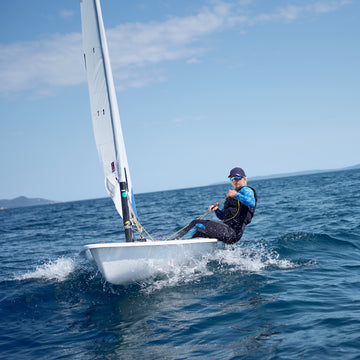
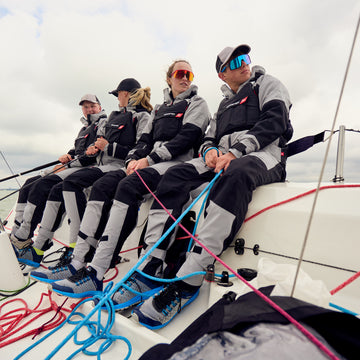
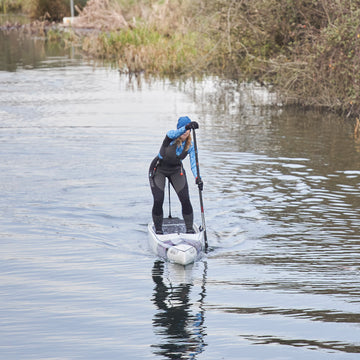
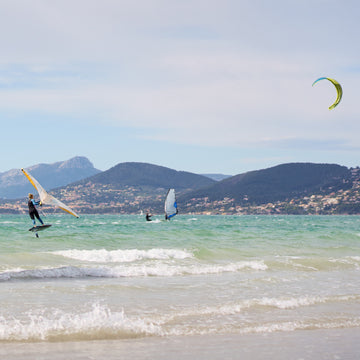

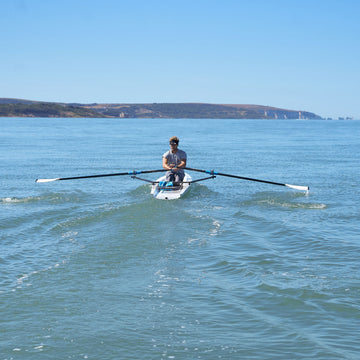
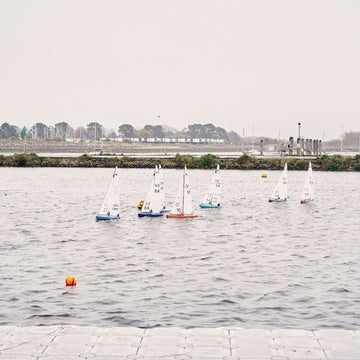
 Select Store
Select Store
 US
US
 UK
UK
